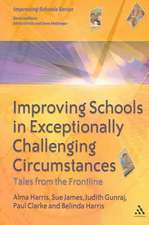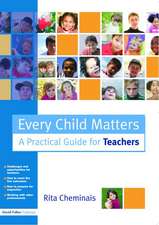Collaborative Leadership: Developing Effective Partnerships for Communities and Schools
Autor Hank Rubinen Limba Engleză Paperback – 25 mai 2009
Southwest Educational Development Laboratory
'Rubin's book provides an eloquent and practical articulation of collaborative leadership and its potential to improve the partnership of communities and public schools'—Wendy Caszatt-Allen, Teacher and Author, Mid-Prairie Middle School, Kalona, IA
Written to inspire and support educators in becoming transformative, collaborative leaders, this updated edition of a best-selling resource demonstrates how educators can use collaboration skills to help shape school culture and build and maintain strong schoolwide relationships that contribute meaningfully to students' learning.
Visionary Hank Rubin provides a broad overview of collaboration in education and lays the foundation for working with colleagues, establishing strong partnerships, and cooperating with students to achieve goals. Updated with the latest research and filled with practical examples, this resource examines 14 phases of collaboration and helps educators:
- Understand the knowledge, skills, and personal characteristics necessary to foster successful collaboration
- Nurture relationships between students and the institutions and individuals associated with learning
- Build collaborative community relationships that support an instructional agenda
- Incorporate the study of collaboration and related reflective activities into leadership practice
By applying these vital principles of collaboration to their work, educators will discover what a school of collaborative excellence is capable of achieving.
Preț: 293.39 lei
Nou
56.14€ • 57.92$ • 46.85£
Carte tipărită la comandă
Livrare economică 26 martie-09 aprilie
Specificații
ISBN-10: 1412965446
Pagini: 160
Ilustrații: Illustrations
Dimensiuni: 178 x 254 x 9 mm
Greutate: 0.66 kg
Ediția:Second Edition
Editura: SAGE Publications
Colecția Corwin
Locul publicării:Thousand Oaks, United States
Recenzii
"Rubin’s book provides an eloquent and practical articulation of collaborative leadership and its potential as a powerful tool to improve the partnership of communities and public schools at all levels, from clients to practitioners to the utilization of community resources."
"Our district is embarking upon the most aggressive strategic plan in our history, and the information contained in this book regarding the attributes of community collaboration serves our district well. I encourage persons seriously interested in community collaboration to review the ideas of Hank Rubin. This book is a must-read for those interested in collaborative leadership.”
“Hank Rubin translates complex, contextually driven processes into digestible bites. The text is compelling, refreshing, and a joy to read. It made me reconsider all that I know about collaboration and where we are as educators.”
“Provides the educator, community and non-profit organizational leaders, and grant makers with explicit information on steps to ensure successful collaborations that will make the lives of students better. Rubin discusses 24 skills and attributes that foster successful collaboration. Collaborative leaders can use this list to analyze their own strengths and weaknesses and select collaborative partners who have skills and attributes that will mesh into a workable whole.”
"The author demonstrates how institutional goals are realized when leaders balance their own sense of ownership and responsibility with the vision and core values of their institutions. This is a must-read for school administrators and those in management who are interested in knowing how collaboration works effectively and successfully toward institutional goal attainment."
"This handbook should be read, thoughtfully reflected upon, and applied by leaders who seek to collaborate with diverse interests to accomplish common goals. All too often, groups will sacrifice what they have in common because of disagreements on relatively minor issues. This handbook is designed for those who understand that much more can be accomplished through collaboration than through conflict. It should be regarded as essential reading for educational leaders at all levels and in a wide variety of positions who seek to apply collaborative strategies to bring about fundamental and enduring improvement in the American educational system."
"In Hank Rubin’s latest book, he emphasizes the importance of teachers as leaders. It is crucial that teachers not only know their content and have pedagogical skills, but must take control of their profession by developing a collaborative learning environment in which all participants are continuous lifelong learners. Learning together makes for a meaningful, relevant educational experience.
"The complexity of both the educational task and its context necessitates new thinking about the traditional concepts and roles associated with educational leadership and school management. This book lays out a guide to these new concepts that incorporate collaborative, symbiotic relationships that are networked within the school’s social system and that reflect a more 'adaptive systems' characteristic with an emphasis on organizational learning."
Cuprins
Preface and Overview
Who Is This Book For?
Building Relationships for Children
A Note to Grantmakers
A Note on Writing a Book
A Quick Guide for the Reader
Dear Reader …
Acknowledgments
About the Author
1. An Invitation to Collaborative Leadership
Cutting Stone
Working Definitions
2. Collaborative Leadership: A Continuing Mandate
In Our DNA
The Importance of Powerlessness
The Position of Mission
The Monitor’s Dim Glow
3. Collaborative Leadership: If We Do It Right
Leveraging Leadership
Beyond Toolboxes
Collaboration and Competition
Collaboration and Creativity
Pushing String: Authenticity and Intentionality
So, Who Is a Collaborative Leader?
4. The Nature of Collaboration
Individual and Representational Participation
Types and Tones of Collaboration
Veracity and Tenacity
A Final Note
5. Most of Us Begin by Missing the Point: Why Education
Democracy’s Midwife
Supporting Education’s Civic Purpose
More Than Memory Banks
Content and Collaboration
Answering the Call for Public Collaborations
6. The 4th R
Looking at Teachers as Collaborative Leaders
Teaching Collaboration for Teaching’s Public Purpose
The Easy Case for Principals and Superintendents as Collaborative Leaders
A Final Thought
Schools and Colleges of Education
7. Constructing Models
The How
It’s All in Your Head!
Constellations-of-Relationships: Thinking Through Relationships
Collaboration’s Life Cycle
Overview
Phase 1: Why Collaborate?
Phase 2: Outcomes? Decision Makers?
Phase 3: Research: Knowledge, Policy, Politics
Phase 4: Stakeholders?
Phase 5: Frame and Recruit
Phase 6: Leaders, Structure, Roles, and Rules
Phase 7: Develop an Action Plan
Phase 8: Begin With Successes
Phase 9: Build Bonds Between Partners
Phase 10: Celebrate Successes
Phase 11: Assess, Adjust, and Reinforce Bonds
Phase 12: Goal-Centered Accountability
Phase 13: Scaffold the Change
Phase 14: Revisit and Renew Mission
Final Note
8. The Dimensions of Collaborative Leadership
Of Sums and Parts
The Value of Clusters
The Personal Dimensions of Collaborative Leadership
The Management Dimensions of Collaborative Leadership
9. Nine Nuggets
A Practitioner’s Postscript
Nine Principles of Effective Collaborative Leadership
Resource A: Planning and Assessment: An Intentional Q&A
Resource B: A New Conceptual Framework: A Tool for Teachers, Curriculum Developers, and Researchers
Resource C: “Schools of Collaborative Excellence”: A Model for School-Based Leaders
References
Index
Notă biografică
Hank Rubin is president of the nonprofit Institute for Collaborative Leadership, former distinguished visiting scholar at George Mason University, and dean-in-residence at the American Association of Colleges for Teacher Education. He was previously joint dean of education at The University of South Dakota and South Dakota State University.
With corporate, political, business, and nonprofit experience, Rubin is a nationally respected collaborative leader, educational spokesperson, and children¿s advocate. Rubin¿s work reflects the vision of one who sees the world through the eyes of a broad cross-section of those who influence the national, regional, and local partnerships needed to make sure that all children can succeed.
He has taught seventh- and eighth-grade students, run three nonprofit organizations and created several others, directed and taught in the Midwest¿s largest urban graduate school of public (government and nonprofit) administration, served as vice president for sales and marketing in an international manufacturing firm, served as associate vice president for institutional advancement in a large urban university, taught graduate students in education and business management, run for¿and held¿public office, and started and managed his own consulting firm before founding the nonprofit Institute for Collaborative Leadership.
Rubin was an early researcher and leader in the field of nonprofit leadership. He was co-convener of the Clarion Initiative (a series of symposia that began at Harvard¿s Kennedy School of Government and produced a framework that has guided nonprofit trainers, educators, and researchers since the 1980s). With more than 20 publications on topics including school reform, educational goal setting, public ethics, philanthropy, and nonprofit management, Rubin is a respected consultant, speaker, and advocate for innovative and collaborative approaches to leadership, training, and public education. He served as Ohiös first associate superintendent for students, families, and communities and was a founding member of both the Ohio Learning First Alliance and the Chicago Panel on Public School Policy and Finance.
Rubin earned his PhD from Northwestern University and his MA and BA from the University of Chicago with early coursework at the State University of New York at Geneseo.














